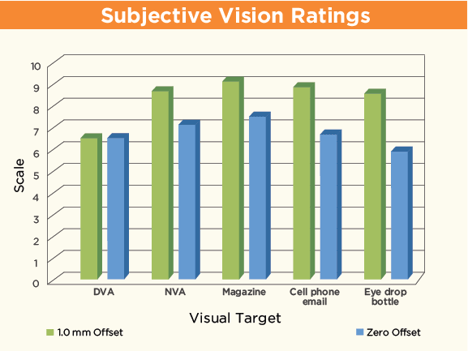It is well-known that not all patients are successful in soft multifocal contact lenses. This is because simultaneous vision multifocal contacts rely on a complex optical delivery system and successful outcomes are determined by a variety of factors. In addition to the lens design, fit, refractive error, ocular surface health, pupil size, and patient expectations, one critical factor is often overlooked – the alignment between the patient’s visual axis and center of the multifocal optics.
Unfortunately, the conventional method of fitting soft multifocal lenses over the center of the cornea does not always ensure appropriate alignment of the multifocal optics over the visual axis. Misalignment can occur due to a variety or combination of factors. These factors include the temporal displacement of the lens, the nasal decentration of the pupil, and a temporally displaced fovea. The study below was conducted with the following objectives:
- Evaluate on-eye performance of both traditional soft multifocal contact lenses with centered optics and 1.0 mm nasally offset optics
- Determine which lens pair performs better from an objective and subjective visual acuity perspective
- Evaluate the amount of offset present with both lens conditions on eye via corneal topography
Study
Twenty-One (21) subjects who met the approved study protocol criteria were enrolled in a randomized, single-masked clinical trial. During the initial visit, baseline measurements were acquired and a diagnostic fitting of the center-near SpecialEyes 54 Multifocal contact lenses occurred. If the fit was appropriate, topography was performed overtop the lenses. Using the topographer’s built-in software, the distance from the visual axis to the center of near optics was measured to determine the misalignment between the two points. Two pairs of lenses were then ordered to include the patient’s subjective vertexed refraction and parameters according to SpecialEyes’ Multifocal Fitting Guide. One set was manufactured with centered optics and the other with optics offset nasally 1.0 mm.
At the follow-up visit, the first set of multifocal contacts were placed on eye and settled for 20 minutes before evaluating. Once appropriate fit was confirmed via slit lamp evaluation, topography was performed overtop the lenses to again measure the amount of misalignment. The results of these findings are found in Table 1.

Table 1.
Then, LogMAR visual acuities at both distance and near were recorded. Additionally, each subject rated their binocular distance and near visual acuity, and their ability to view the following specific targets held at a set distance:
- Article in a magazine
- Email on a cell phone
- Usage instructions on an eye drop bottle
For each viewing task, subjects were asked, “On a scale from 1 to 10, with 10 being the best vision and 1 being the worst, how would you rate the quality of your vision?” All near sighted tasks were performed at 16 inches in a light controlled exam lane. The same procedures were repeated for the second set of lenses.
Results
When comparing the multifocal contacts with zero offset to the lenses with 1mm offset, there was no statistically significant difference (SSD) in objective measurement of distance visual acuity with either lens pair (p = 0.43). However, as you can see in the graphs below, the 1.0 mm nasal offset lenses provided both a statistically and clinically significant difference in objective near visual acuity (p = 0.04) , as well as a subjective preference when viewing various types of near targets.

Graph 1. The average LogMAR acuity for distance and near with each lens pair

Graph 2. The average subjective vision ratings when viewing various targets
Additionally, 19 out of 20 subjects who completed the study (one subject was eliminated due to inadequate fit) stated that they favored the lens pair with offset optics. Furthermore, the responses from the subjects while wearing the multifocal contacts with offset optics included:
- There are no overlapping letters.
- I have less of a 3D effect.
- The double letters are gone.
- I don’t see a halo around the letters anymore.
Conclusion
In conclusion, this study shows the importance of evaluating a misalignment between a patient’s visual axis and the center of multifocal contact lens optics. When a misalignment is present, soft multifocal contact lens patients can experience reduced acuity, induced aberrations, and unwanted visual phenomena (3-D, ghosting, etc.). In these patients, nasally offsetting the optics to be more appropriately aligned with a patient’s visual axis can improve both visual acuity and quality of vision.
If you suspect that your patient might be suffering from a multifocal misalignment issue, be sure to read our post “3 Ways to Identify a Misalignment” or visit our OptiSync® Technology page to learn more.
